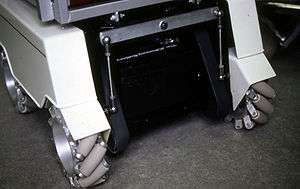Mecanum wheel



The Mecanum wheel is a design for a wheel which can move a vehicle in any direction. It is sometimes called the Ilon wheel after its Swedish inventor, Bengt Ilon, who came up with the idea in 1973[1] when he was an engineer with the Swedish company Mecanum AB.
It is a conventional wheel with a series of rollers attached to its circumference. These rollers typically each have an axis of rotation at 45° to the plane of the wheel and at 45° to a line through the centre of the roller parallel to the axis of rotation of the wheel.[1] A typical configuration is the four-wheeled one of the URANUS omni-directional mobile robot (pictured) or a wheel chair with Mecanum wheels (similar to that pictured). By alternating wheels with left and right-handed rollers, in such a way that each wheel applies force roughly at right angles to the wheelbase diagonal the wheel is on, the vehicle is stable and can be made to move in any direction and turn by varying the speed and direction of rotation of each wheel. Moving all four wheels in the same direction causes forward or backward movement, running the wheels on one side in the opposite direction to those on the other side causes rotation of the vehicle, and running the wheels on one diagonal in the opposite direction to those on the other diagonal causes sideways movement. Combinations of these wheel motions allow for vehicle motion in any direction with any vehicle rotation.
The US Navy bought the patent from Ilon and put researchers to work on it in the 1980s in Panama City. The US Navy has used it for transporting items around ships. In 1997, Airtrax Incorporated and several other companies each paid the US Navy $2,500 for rights to the technology, including old drawings of how the motors and controllers worked, to build an omnidirectional forklift truck that could maneuver in tight spaces such as the deck of an aircraft carrier. These vehicles are now in production.
Tracked vehicles and skid steer vehicles utilize similar methods for turning. However, these vehicles typically drag across the ground while turning and may do considerable damage to a soft or fragile surface. The high friction against the ground while turning also requires high-torque engines to overcome the friction. By comparison, the design of the Mecanum wheel allows for in-place rotation with minimal ground friction and low torque.
See also
References
- 1 2 "Improved Mecanum Wheel Design for Omni-Directional Robots" (PDF). Institute of Technology and Engineering, Massey University. November 2002. Retrieved 22 September 2011.
External links
- US 3876255, Bengt Erland Ilon, "Wheels for a course stable selfpropelling vehicle movable in any desired direction on the ground or some other base", published 8 April 1975
- Airtrax video
- Orlando Business Journal article Omnics' wheel of fortune rolls into production by Chad Eric Watt, 31 May 2002.
- The Wall Street Journal online Make It by Paulette Thomas, 9 May 2005.
- Wheel chair with Mecanum wheels. The wheel chair was presented at the 2006 EVER Monaco.
- Segway RMP Video of a Segway robot with Mecanum wheels.
- CMU's "Tessellator" robot designed in 1992 for servicing Space Shuttle tiles used Mecanum wheels.
- CMU's "URANUS Omni-Directional Robot" built with Mecanum wheels in 1985 and used for two decades for autonomous navigation research.